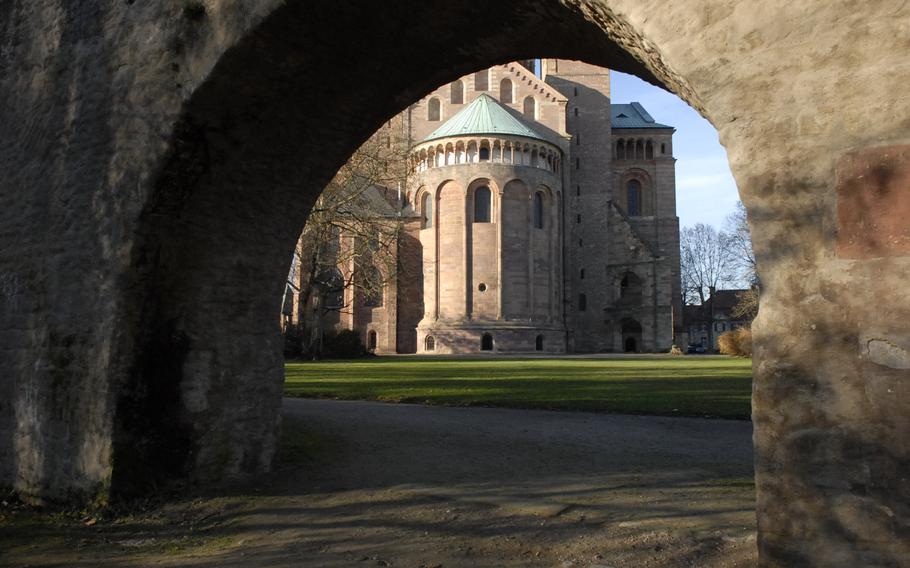
Part of the Speyer cathedral in Speyer, Germany, can be seen through a stone arch from the gardens surrounding the east end of the cathedral. The cathedral is the world's largest-standing Romanesque church. The original construction of the massive stone structure was completed in 1061. (Jennifer H. Svan/Stars and Strip)
If the cathedral in Speyer, Germany, were built in an unremarkable city, it would still be worth a visit for history buffs, lovers of old cathedrals and religious devotees.
Officially known as the Cathedral of St. Mary and St. Stephen, the cathedral is steeped in history, a massive block of rock that stands as a timeless piece of Romanesque architecture.
But the real draw of the cathedral is its location. The centuries-old basilica, with four towers and two domes, looms at the center of one of the Rhineland-Palatinate’s gems of a city.
With its meandering cobblestone streets, quaint stores and cafes and eclectic architecture not far from the banks of the Rhine River, Speyer has plenty of Old World charm. It’s a must-see city for anyone living in Germany, and a visit to the Speyer cathedral only adds to the allure of one of Germany’s oldest cities.
The cathedral — dom in German — is impressive to behold. It bookends one end of Maximillian Strasse, Speyer’s old city boulevard, and dominates the surrounding landscape. Laid out in the shape of a Latin cross, the cathedral is the world’s largest-standing Romanesque church boasting some eye-popping dimensions: The structure is 439 feet in length (about 80 feet longer than a football field) and 124 feet wide, with a pair of square towers on either end, standing taller than 200 feet.
Once inside, the focal point is the central nave, a huge, open space flanked by contrasting yellow, red and beige sandstone pillars leading up to the high altar and apse. A huge crown that would fit the head of a giant hangs from the ceiling.
The look is largely plain, almost austere; there are no stained-glass windows or glittering decorations common to cathedrals of later eras.
But the simple interior, ambient light and vaulted arches throughout lend it a stately yet spiritual feel, a mingling place for history and religion.
Knowing the story of how the cathedral came to be makes a visit there more interesting. A dually crowned German king and Holy Roman emperor, no doubt attempting to flex his holy royal muscles, ordered the cathedral to be built around 1030.
Conrad II was the first of four kings and emperors of the Salian dynasty, which ruled from 1024 to 1125. Though Speyer was tiny during Conrad’s reign, with an estimated 500 people, the king’s goal was to build the biggest church of his era, an apparent bid to demonstrate his claim to power against the Roman Catholic Church, according to the city’s website.
Conrad died of gout in 1039 and never saw the completion of his masterpiece, a massive undertaking that took 30 years to build. But it turned out to be Conrad’s final resting place — for most of him, that is. His body was buried at the cathedral, while it was still under construction; his heart and bowels were interred at a cathedral in Utrecht, Netherlands, where he died.
Conrad’s remains lie in the cathedral’s crypt, the grave site of no fewer than eight German emperors and kings, four queens and a number of bishops. The crypt is one of the few unaltered sections of the cathedral, much of which was destroyed and rebuilt over the years. Despite not having much of its original stonework, the cathedral was designated a World Heritage Site in 1981.
The English brochure about the crypt describes it as the largest Romanesque crypt in the world. There’s not much there to see, except more stonework, a few darkened rooms and two rows of flat stone tombs. A more interesting option leads upward. Beginning in April and throughout the summer, one of the cathedral’s towers is open. Visitors can climb to an observation deck and the Emperor’s Hall, featuring the recently restored exhibition of nine frescoes by Johann Baptist Schraudolph.
Visitors can access the observation deck only if they are on a group tour, which costs 6 euros. But the price might be worth it for the view. On clear days, one can see up to 30 miles, according to the Speyer city website.
svan.jennifer@stripes.com
Directions Find the cathedral at Domplatz, 67346 Speyer, Germany.
Times Monday to Saturday, 9 a.m. to 5 p.m., from November to March; and 9 a.m. to 7 p.m., April to October. The cathedral is open from noon to 5 p.m. on Sundays year-round. No visitation during church services.
Costs Entrance to the main cathedral is free. Admission to the crypt is 3 euros. From April to October, the Emperor’s Hall and the observation platform are open. Cost is 6 euros for adults; children under age 18 and persons with disabilities, 3 euros. Metered parking is available near the cathedral. Books, CDs and souvenirs can be purchased at a pavilion south of the cathedral.
Food Restaurants and cafes are in walking distance of the cathedral, in Speyer’s old city district.
Information Website: http://speyer.de; phone: (+49) (0) 6232 102118.